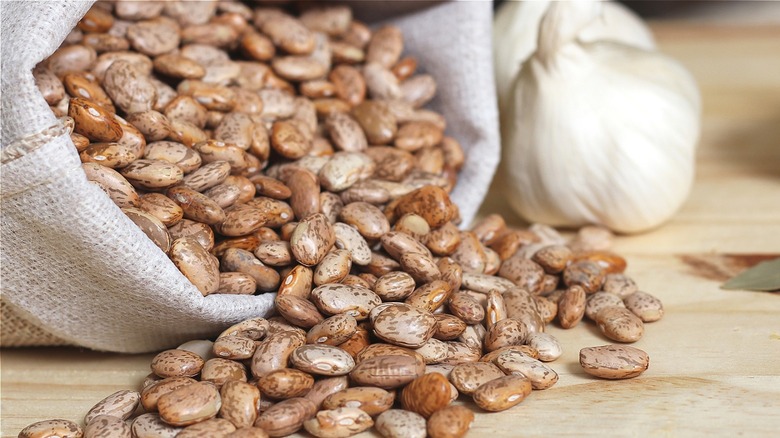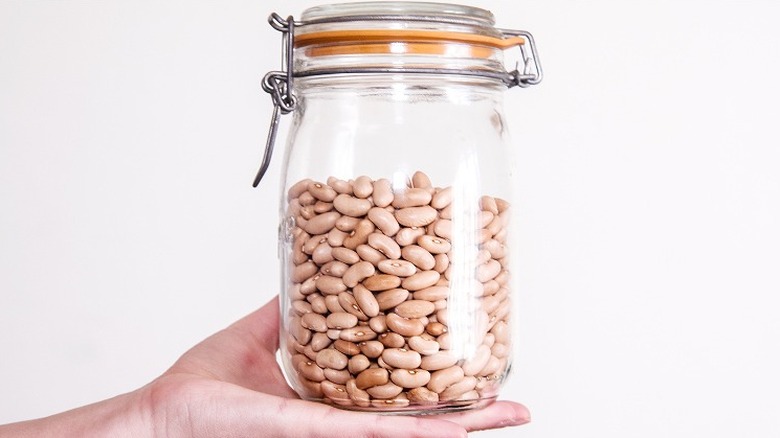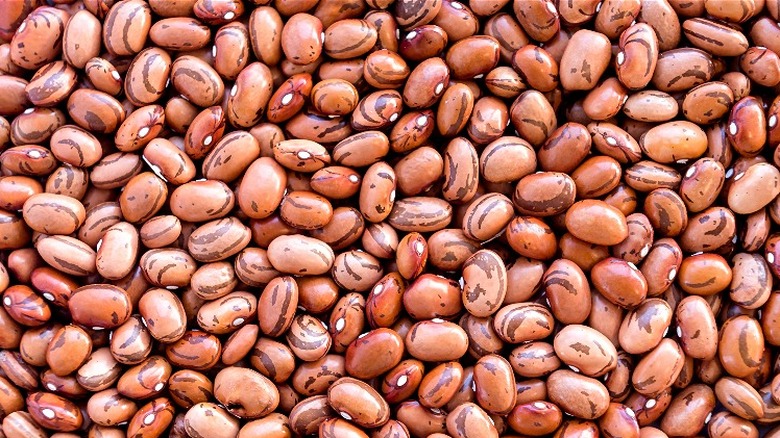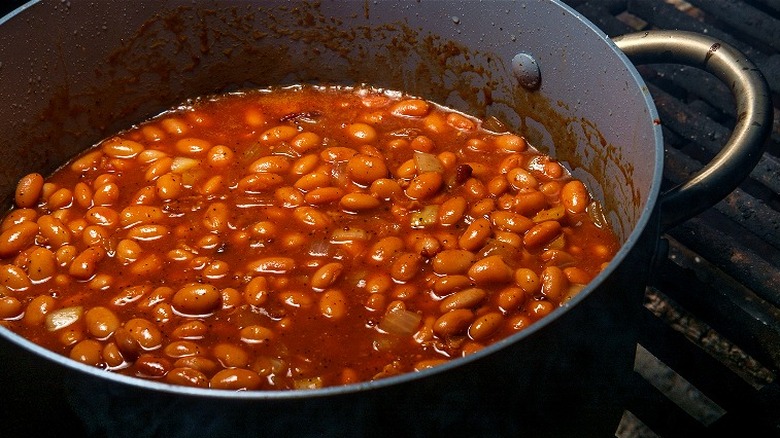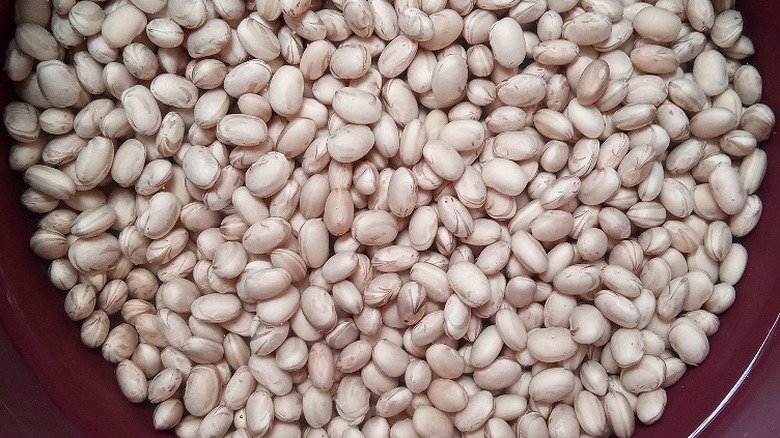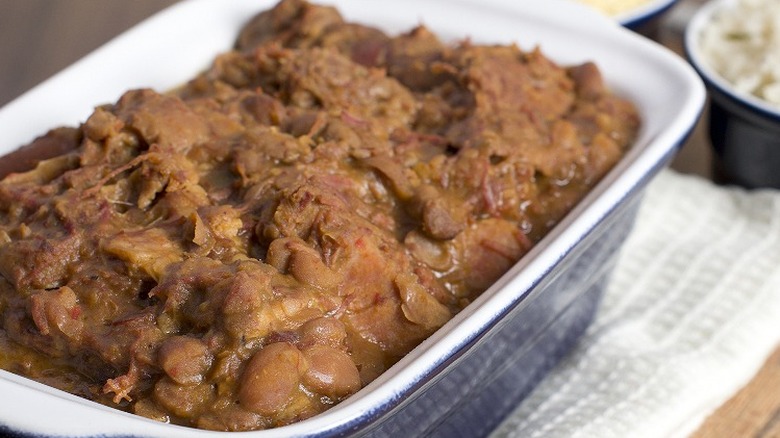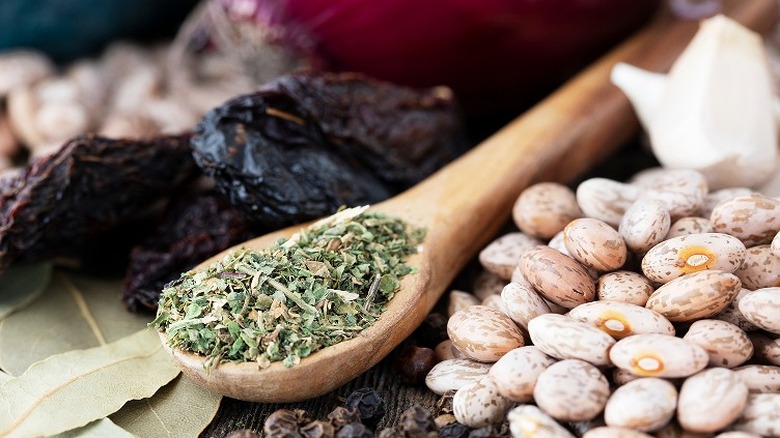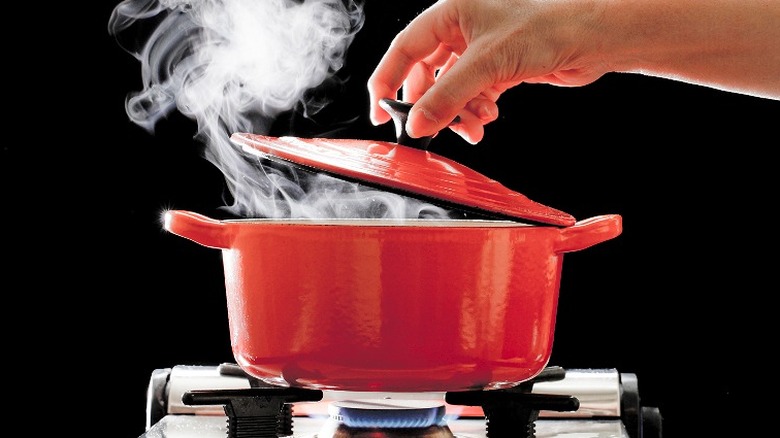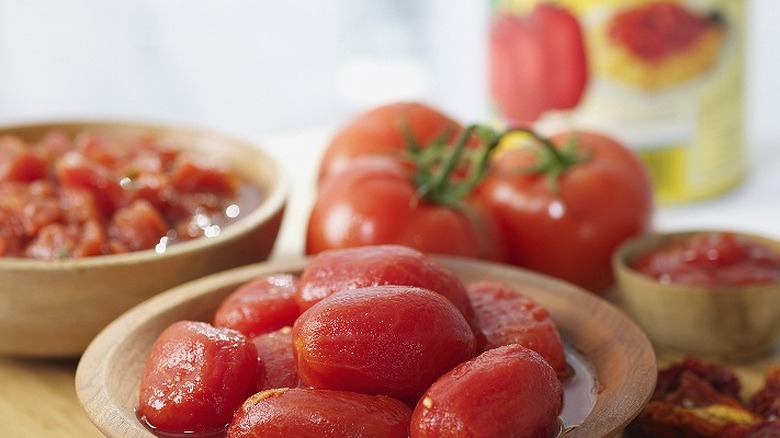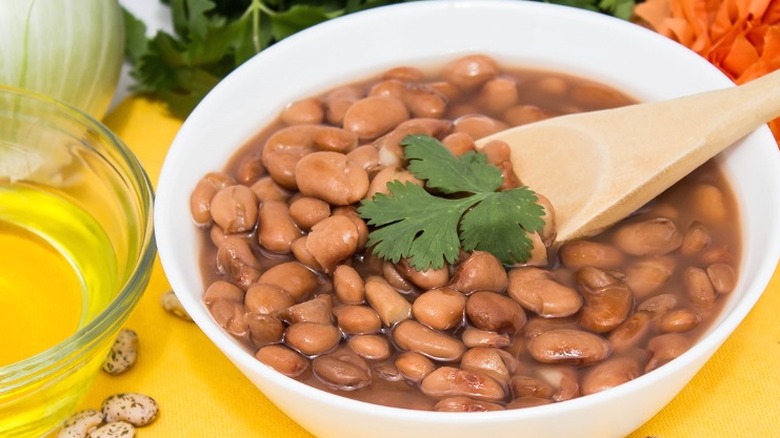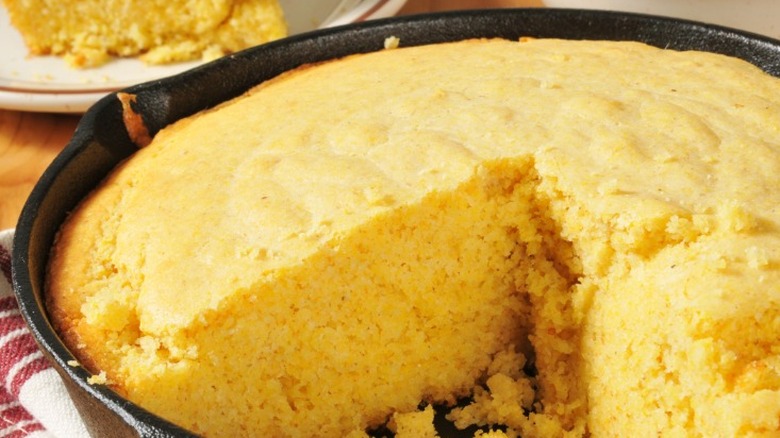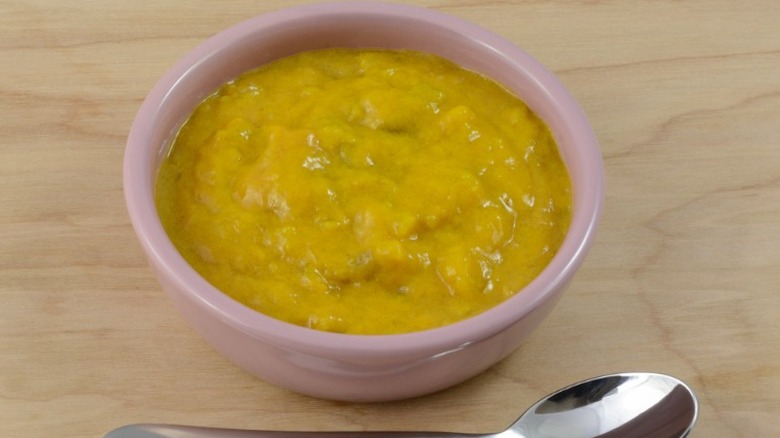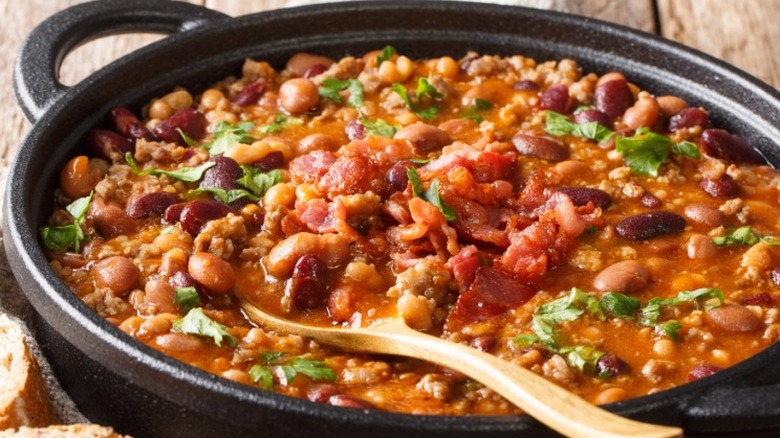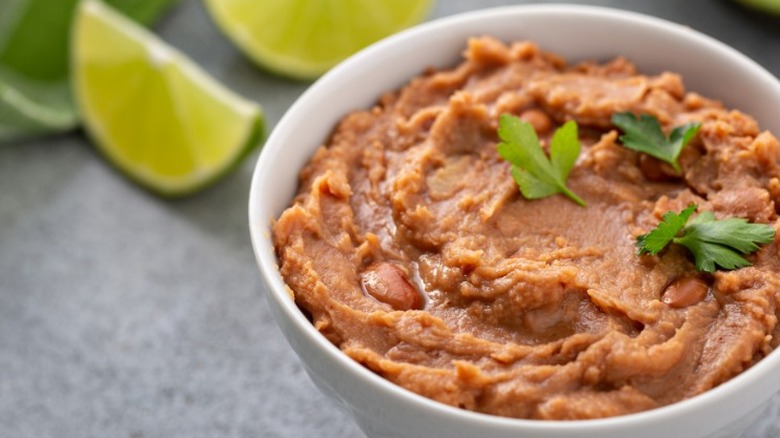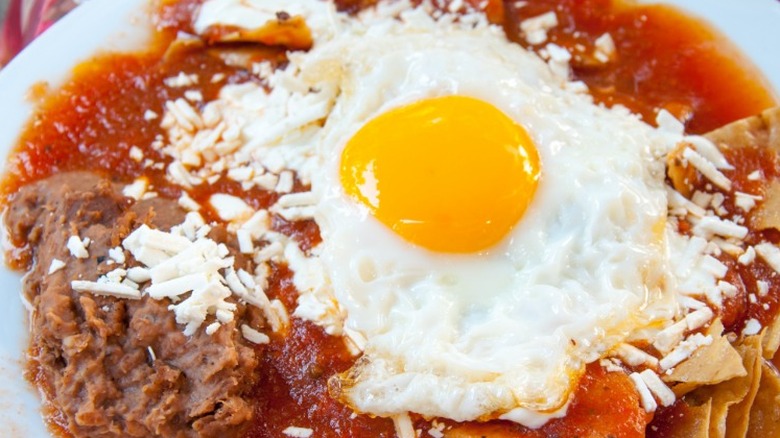14 Tips You Need When Cooking With Pinto Beans
There's something comforting about a big bowl of perfectly-cooked pinto beans. It's a true soul food that has warmed the hearts and stomachs of people from different cultures for several lifetimes. Pinto beans are a staple of cuisine in Mexico, where they have been cultivated for at least 5,000 years. They've been grown in what is now New Mexico for just as long, playing a big part in southwestern cooking. (In fact, the pinto bean is the state vegetable of New Mexico, along with the chile.) On the eastern side of the United States, pinto beans are an important part of Appalachian foodways, and many a Southerner grew up on soup beans and cornbread.
Even though pinto beans are among the most popular types of beans, in today's DoorDash world, cooking them is becoming a lost art. If you'd like to make your own, there are some tricks you should know, but don't be put off by the prospect. Nobody is born knowing how to cook beans. Our ancestors learned by trial and error, acquiring wisdom along the way. You can learn it too, and thanks to the internet, you can do it without the "error" part. Use these tips to ensure that your first pot of pinto beans tastes like you've been cooking them for a lifetime.
Check the date
Technically, dried pinto beans can last almost forever, but that's under optimal storage conditions. Beans should ideally be stored in airtight containers in a cool, dark, dry place. Even when stored in the perfect pantry, beans will start to lose their nutritional value after a couple of years and are almost completely devoid of nutrition after five years. You definitely don't want to miss out on all the good stuff beans can deliver. Pinto beans are little powerhouses of protein and fiber and have a fair share of B vitamins and anti-oxidants, too.
There's another reason you don't want to wait too long to use your beans: cooking time. The older the beans, the longer they will take to cook. After a certain amount of time, all the cooking in the world won't soften the beans. (They're still edible, which makes them useful for long-term emergency food supplies, but they will be far from delicious.) A teaspoon of baking soda can help soften older beans, but don't overdo it, or you'll affect the taste. The bottom line is: use up your beans within a year, and you won't have to worry about extended cooking times or loss of nutrition.
Sort and rinse
The first step in cooking dried beans (of any kind) is to ensure they are free from dirt and debris. While most people know to rinse their beans, many people skip the sorting process. You might think you don't need to sort, but it only takes one broken tooth to learn the lesson the hard way. Pinto beans are harvested by machine, so almost anything can end up in your bag, especially if that something is a bean-shaped rock. USDA regulations allow 0.5% foreign matter (including stones) in dried pinto beans, so you can also encounter bits of dried dirt, sticks, or even insect materials.
To sort beans, you can spread them out on a cookie sheet to see them well and discard anything non-bean. You should also discard all the broken or weird-looking beans, as they might look that way because a pest bored into them. After sorting, you can rinse the beans in a colander. Some people like to sort as they rinse, looking through the beans with their hands as the water runs through, but if you do this, take care to be thorough. Bonus tip: an advantage of the cookie sheet method is that kids can help with the sorting, and they often enjoy finding and picking out the freakish beans.
Prepare for expansion
If you're new to cooking dried beans from scratch, you should be aware of how much water the beans will absorb. It's a lot more than you think. You know that shock you sometimes feel when you sauté a huge bunch of spinach, and it cooks down into a small clump? Well, it's the opposite with beans. If you don't add enough water to your dried pintos, and if your cooking pot is too small, you just might return to the kitchen to find a bean-splosion. Expanding beans can even knock the lid off of your pot, and once the water is all absorbed, the beans will also burn and stick to the bottom of the pot.
The ratio you need is 3:1. That's 3 cups of water to every 1 cup of dried beans. You don't have to use a measuring cup so long as you have three times as much water. You can use an empty can, a coffee mug, or just eyeball it if you have the confidence. You also need to ensure that your cooking pot has room for the beans to expand to three times their size. Note that you may want to use a little more water for Southern-style pinto beans to achieve the stew-like consistency.
Know when to soak
People who cook a lot of beans can be divided into two camps: the pre-soakers and the no-soakers. While it's true that you don't have to spend your time soaking pinto beans, there are reasons you might want to. The main argument against pre-soaking is that you could be spending all that soaking time actually cooking the beans. This doesn't hold up when you consider that beans can be soaked overnight while sleeping, and some people aren't comfortable leaving a cooker on during that time. An overnight soak reduces the cooking time for the next day.
Soaking makes a difference, too, when you're contending with old beans, which take longer to soften, as mentioned above. If you stocked up on dried pinto beans at the beginning of the pandemic, when many people were prepping their pantries, those beans will need a long soak. You can soak overnight in a pot of water, or use the quick-soak method by bringing the beans to a boil, then turning off the heat and letting them sit for a few hours. Either method will soften the beans and reduce cooking time.
Add pork for flavor
Beans don't have a lot of flavor on their own. That doesn't mean they're not delicious. Some of the best foods in the world are pretty bland until you dress them up with things like butter and salt (we're looking at you, potato). The most common way to add flavor to a pot of pinto beans is by cooking them with pork. Recipes for Southern-style pinto beans usually call for salt pork or fatback. Traditional African-American variations will often use ham hocks instead. The fat is as important a component as the meat flavor, adding richness to the cooking liquid. If fatback and ham hocks are not easy for you to acquire, try adding some bacon or sausage links.
Vegetarians can skip the pork, of course, but for full-flavored beans, you'll want to compensate for its absence. Think umami. You can achieve some of the savory, smoky flavor profile with a big splash of tamari or a dollop of tomato paste (only add the latter after cooking). Smoked paprika is a nice addition if you like the spice. Smoked salt does double duty, adding both the smokiness and the saltiness that pork would bring.
Don't skimp on the seasonings
You know that old saying about how the number one rule of real estate is location, location, location? The number one rule of cooking beans is seasoning, seasoning, seasoning. All foods should be seasoned properly, of course, but because beans have so little flavor on their own, they need to be seasoned every step of the way. That means adding salt to the cooking water from the very start. Some folks say salt stops the beans from cooking, but that's a culinary myth. In fact, some chefs go a step further and even pre-soak their beans in a salty brine. Brining actually leads to softer beans.
While salt and pork (or whatever you are substituting for the pork) are the main ways to bring flavor to your pinto beans, for a fully complex flavor profile, you'll want to add additional seasonings. With experience, you'll find your own preference for seasoning amounts and combinations, so don't be afraid to wing it. Popular choices for seasoning beans include cumin, paprika, garlic, and bay leaves. Chopped onion is a must-have addition for many cooks. If in doubt, follow a recipe to get started. This spicy instant pot pinto beans recipe can teach you a thing or two about flavor.
Leave them alone
As tempting as it can be to steal a little taste of your pinto beans, try to resist the temptation to mess around with them too much. They're not like a delicate risotto that needs constant stirring and attention. Taking the lid off of the pot and stirring too much can cause the skins of the beans to burst. Simmer on low, and be patient. If you're using a slow cooker, it's even more important not to peek, as every time you let the steam escape, you lower the temperature and add on to the needed cooking time.
But aren't you supposed to taste as you go? Yes, usually. Tasting as you cook is always a good rule of thumb, but with beans, you're better off letting them soften before you start adjusting things. You can always add more seasonings later if you need to, and then simmer a little more. Beans are difficult to overcook, as long as you keep the temperature low and always have enough water. In fact, reheating beans makes them even more creamy.
Save acidic ingredients for the end
Though seasoning is important, there are some ingredients you'll want to keep away from your pinto beans until you're finished with cooking. Acidic ingredients delay the softening of the beans, sometimes adding hours to your cooking time. The high amounts of acid in certain foods penetrate the skins of the beans and bind with them to create a barrier that keeps out water. Without water absorption, you have beans that stay hard and chewy.
Tomatoes are one of the biggest culprits behind pinto beans that never seem to soften, as people tend to add them to beans in preparation for making chili. Smart cooks know to add them only after the beans are cooked. Other ingredients to save until the beans are soft include lemon juice, wine, and vinegar. Don't forget that tomato sauce, tomato paste, ketchup, and canned tomatoes are just as acidic as fresh tomatoes, so hold off on them as well.
Don't ditch the cooking liquid
When you're done cooking your beans, don't make the rookie mistake of draining them. To Southerners, the rich broth is practically liquid gold. Known as pot liquor or potlikker, the salty, seasoned liquid left after cooking beans or greens is perfect for mopping up with cornbread or biscuits. Discarding the pot liquor means discarding the most flavorful part of your pot of pinto beans. And after all that work? Waste not, want not.
If your beans are earmarked for a dish that doesn't require soupiness, you still don't have to throw away the liquid. You can drain the beans in a colander over a bowl or pot to make sure you don't lose any pot liquor, then save or freeze it to use as a stock base for soups and gravies. The taste is far richer and more flavorful than any commercial soup stock.
Make cornbread
Just as biscuits need gravy, a pot of pinto beans needs cornbread. The pairing is iconic of southern Appalachian cuisine for a good reason. A hot, crumbly buttermilk cornbread recipe makes a full meal when paired with beans, and nothing's better for sopping up the scrumptious pot liquor (which you now know not to throw away). True cornbread connoisseurs know that the best cornbread is made in the searing-hot edges of a cast iron skillet.
There are warring factions of people with differing opinions about cornbread and whether it should be sweet or savory. Some Southerners would run you out of town for adding sugar to cornbread, and others might argue that a splash of honey is due, but the truth is that both kinds have their place — but not with beans. Crumbly cornbread without sugar is the traditional accompaniment for pinto beans. If you like the sweet kind, save it for dessert.
Don't forget the accompaniments
In the South, pinto beans and cornbread make a simple and humble meal, but that doesn't mean they're always eaten completely naked. The condiments are part of the experience when serving and eating a pot of beans. Traditionally, pinto beans are eaten in Appalachia with chopped raw onion, wild ramps, or fresh green onions. (Green onions are usually served whole when accompanying pinto beans, and the diner can cut pieces into their bowl or just chomp on it as they go.)
Another popular topping is chow chow, a pickled relish that could be thought of as the salsa of the South. The sharp cabbage-based pickle dish perfectly contrasts the creamy smoothness of pinto beans, and southern households go through jars of it quickly. Regular salsa, hot sauce, pepper sauce, or chutney are all fine condiments for pinto beans, especially for those who like a little zing. For Tex-Mex style pintos, serve with cilantro and lime wedges.
Change up the recipe for chili
Though plenty of people make a pot of beans to eat on their own, you might be making pinto beans to use for chili later. If that's the case, season them before cooking with Tex-Mex flavor in mind. Try chorizo in place of salt pork for a more Southwestern taste. You can also puree a can of chipotles in adobo for extra richness and heat. There's no shame in red or green bell peppers if you don't like a lot of heat, but if you do, go for the hottest peppers you enjoy.
If you have other dishes in mind for your pinto beans, then season accordingly. Greek bean soup has a very different flavor profile than southwestern dishes, so you'll want to season your pintos with garlic, oregano, and olive oil (and a squeeze of lemon, but only at the end). Pinto beans are versatile, and you can angle the flavor profile in any direction you like.
Keep your refried beans creamy
One of the best things about making a big pot of pinto beans is using them to make refried beans. With time at a premium, you can always take a shortcut with an Instant Pot refried beans recipe, but the best kind of refried beans will always be those made in a skillet. All you have to do is add your pinto beans and some water, heat on medium-high, and whisk until smooth.
If your refried beans always turn out hard and clumpy, there's a simple secret you can master. Like scrambled eggs, refried beans will keep cooking and reducing even after you remove them from the cooking source. That means to keep them soft and creamy, remove the beans from heat just before they're completely reduced. Now they're ready to be made into tacos or burritos or served as a side dish for your arroz con pollo.
Get inventive with leftovers
Even the biggest pinto bean lovers can get tired of them before the pot is empty. Chili and refried beans are the most obvious go-to uses for leftover beans, but they're certainly not the only ones. You can add pinto beans and rice to burrito bowls or use the beans to top a pan of nachos with lots of onions and cheese. For breakfast, pintos make a handy base for huevos rancheros.
You can substitute pintos for other beans in plenty of recipes, too. They're an easy, varied swap-out for black beans, but you can also use them more creatively as a stand-in for lentils, lima beans, or white beans. Why not try pinto bean hummus? Just switch your chickpeas for pinto beans, and you're one blender blitz away from an appetizer. Craving pizza and those South of the Border flavors? You've already got your spread for a Mexican pizza recipe.
